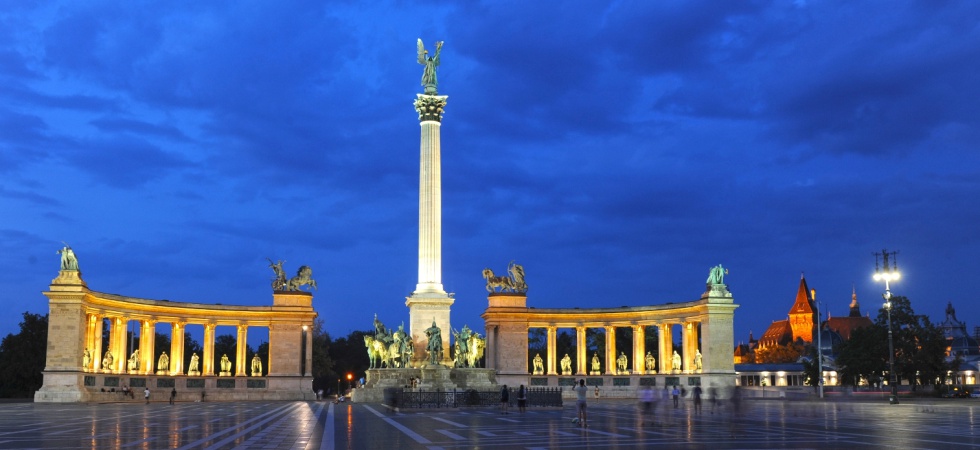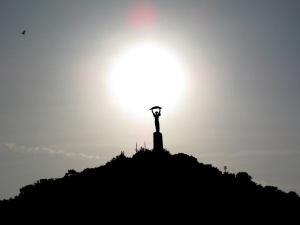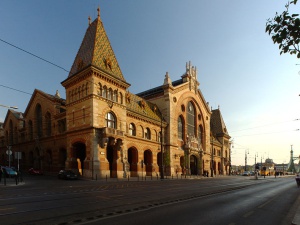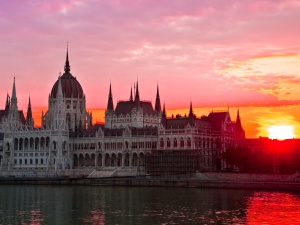Tourist Guide
Useful Links
Must see places in Budapest
-

Heroes Square
Hősök tere is surrounded by two important buildings, Museum of Fine Arts on the left and Palace of Art (or more accurately Hall of Art) on the right. On the other side it faces Andrássy Avenue which has two buildings looking at the square — one is residential and the other one is the embassy of Serbia (former Yugoslavian embassy where Imre Nagy secured sanctuary in 1956).
The central feature of Heroes' Square, as well as a landmark of Budapest, is the Millennium Memorial. Construction began in 1896 to commemorate the thousandth anniversary of the foundation of the Hungarian state by St. Stephen I in 896, and was part of a much larger construction project which also included the expansion and refurbishing of Andrássy Avenue and the construction of the first metro line in Budapest (Hungarian: Földalatti). Construction was completed in 1900, which was when the square received its name. learn more...
-

Gellért Thermal Bath and Hotel
We find records about the "miraculous" springs spurting up on the territory of the Bath from as early a date as the 15th century. These springs were later favoured by the Turks as well, as they were larger and hotter than the Buda baths of the period. In the 17th century, the site was named Sárosfürdő (Mud bath) because of the fine spring silt that was pushed up together with the spring water and settled at the bottom of the pools. The Gellért Thermal Bath and Hotel, known world-wide and highly favoured by foreigners, built in a secession style, opened its gates in 1918 and was expanded in 1927 by the wave-bath and in 1934 by the effervescent bath. In the course of the modernisation accomplished in our days, the sitting-pool in the swimming complex, the outdoor sitting pool and the children's pool were renovated; they were equipped with a state-of-the art water filtering and circulation device. At present, nearly all healing facilities may be used in the Gellért Thermal Bath. The Bath includes a department offering complex thermal bath acilities (daytime/outpatient hospital), it also has an inhalatorium. learn more...
-

Chain Bridge & Buda Castle
The Széchenyi Chain Bridge a suspension bridge that spans the River Danube between Buda and Pest, the western and eastern sides of Budapest. Designed by the English engineer William Tierney Clark, it was the first permanent bridge across the Danube in Hungary, and was opened in 1849. It is anchored on the Pest side of the river to Széchenyi (formerly Roosevelt) leading to Buda Castle. learn more...
Buda Castle is the historical castle and palace complex of the Hungarian kings in Budapest, and was first completed in 1265. In the past, it has been called Royal Palace and Royal Castle. Buda Castle was built on the southern tip of Castle Hill, bounded on the north by what is known as the Castle District, which is famous for its Medieval, Baroque, and 19th-century houses, churches, and public buildings. It is linked to Clark Ádám Square and the Széchenyi Chain Bridge by the Castle Hill Funicular. The castle is a part of the Budapest World Heritage Site, which was declared a Heritage Site in 1987. learn more...
-

Gellért Hill & Liberty Statue
Gellért Hill is a 235 m (771 ft) high hill overlooking the Danube in Budapest, Hungary. It is part of the 1st and 11th Districts. Gellért Hill was named after Saint Gerard who was thrown to death from the hill. The famous Hotel Gellért and the Gellért Baths can be found in Gellért Square at the foot of the hill, next to Liberty Bridge. The Gellért Hill Cave is located within the hill, facing toward Hotel Gellért and the Danube River. At the top of the hill is the Citadella (Citadel), from which a view is available down both directions of the Danube. learn more...
It was first erected in 1947 in remembrance of the Soviet occupation of Hungary during World War II, which ended the occupation by Germany. Its location upon Gellért Hill makes it a prominent feature of Budapest's cityscape. The 14m tall bronze statue stands atop a 26m pedestal and holds a palm leaf. Two smaller statues are also present around the base. The monument was designed by Zsigmond Kisfaludi Stróbl. learn more...
-

Great Market Hall & Váci Street
The Great Market Hall or Central Market Hall (Hungarian "Nagycsarnok"), on Fővám Tér in the 9th district, is the largest and oldest indoor market in Budapest. The idea of building such large market hall arose from the first mayor of Budapest, Károly Kamermayer, and it was his largest investment. He retired in 1896 so when the building was completed, he participated in the opening ceremony as a citizen. It is located at the end of the famous pedestrian shopping street Váci utca and on the Pest side of the Liberty bridge. The building was designed and built by Samu Pecz around 1897.[1] The market offers a huge variety of stalls on three floors. The entrance gate is with neogothic touch. learn more...
Váci utca (Váci street) is one of the main pedestrian thoroughfares and perhaps the most famous street of central Budapest, Hungary. It features a large number of restaurants and shops catering primarily to the tourist market. The Lonely Planet says "It's tourist central, but the line of cafés and shops are worth seeing — at least once." learn more...
-

Hungarian Parliament Building
The Hungarian Parliament Building is the seat of the National Assembly of Hungary , one of Europe's oldest legislative buildings, a notable landmark of Hungary and a popular tourist destination of Budapest. It lies in Lajos Kossuth Square, on the bank of the Danube. It is currently the largest building in Hungary and still the tallest building in Budapest. The Parliament Building is in the Gothic Revival style; it has a symmetrical facade and a central dome. The dome is Renaissance Revival architecture. Also from inside the parliament is symmetrical and thus has two absolutely identical parliament halls out of which one is used for the politics, the other one is used for guided tours. It is 268m (879ft) long and 123m (404ft) wide. Its interior includes 10 courtyards, 13 passenger and freight elevators, 27 gates, 29 staircases and 691 rooms (including more than 200 offices). With its height of 96 m (315 ft), it is one of the two tallest buildings in Budapest, along with Saint Stephen's Basilica. The number 96 refers to the nation's millennium, 1896, and the conquest of the later Kingdom of Hungary in 896. learn more...

